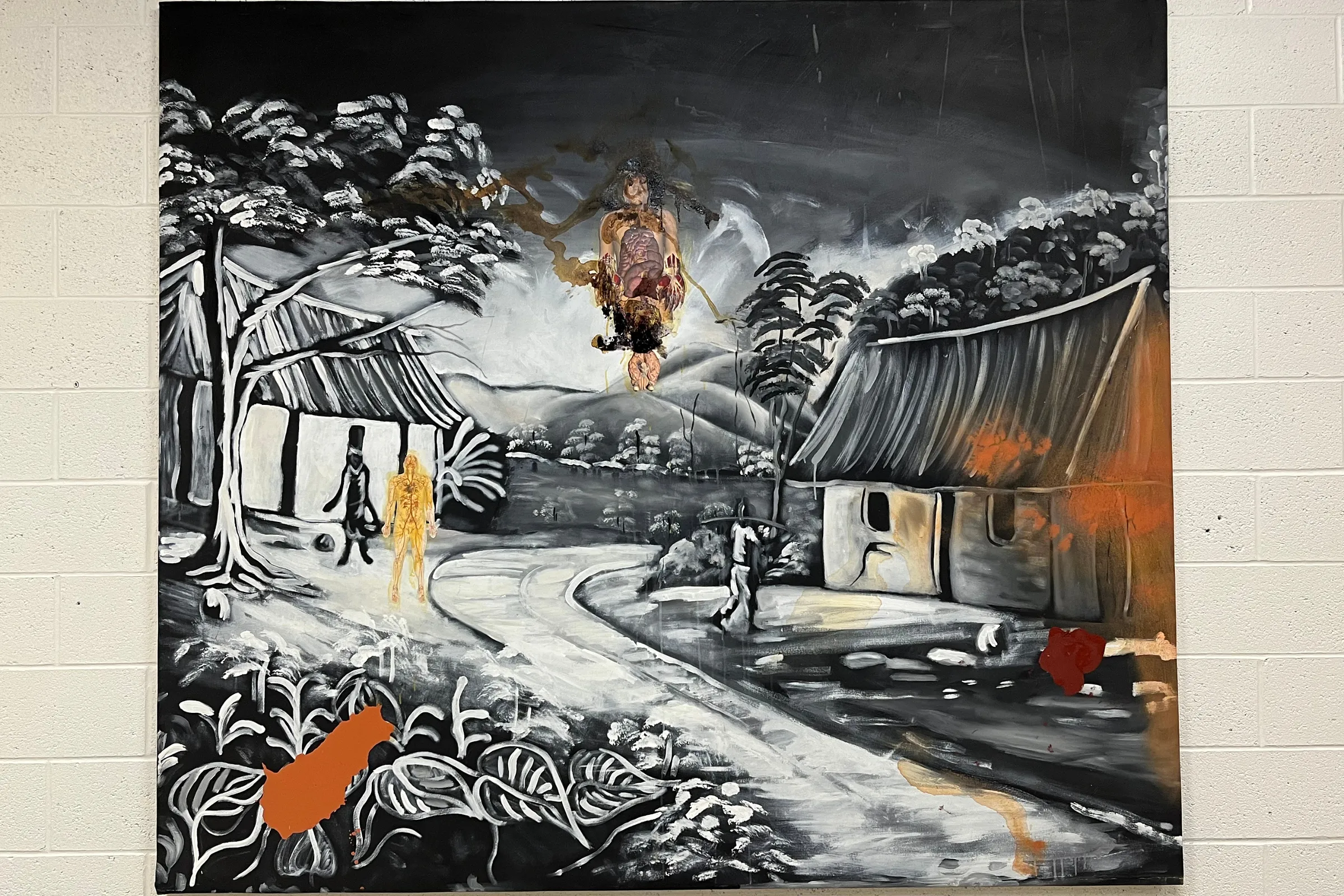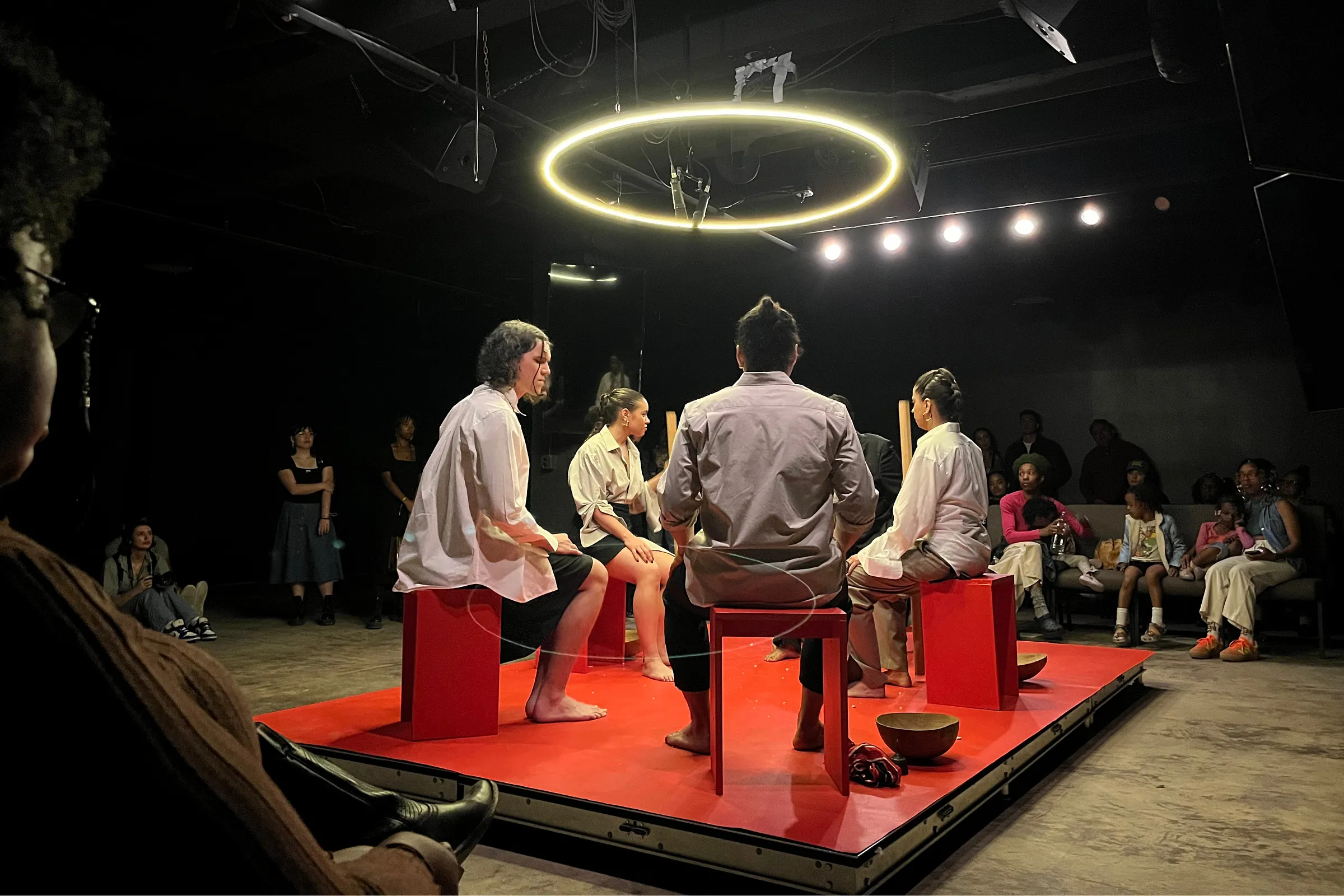Sovereign Futures
Various locations
April 4 – 7, 2024
Sovereign Futures, a multi-day program from the University of Tulsa, brought artists, academics, and others together for performances, exhibits, communal meals, chartered bus tours to Boley and Pawhuska, panel discussions and more around the stories of sovereignty that meet in Indian Territory. Curated by TU’s Allison Glenn, this felt like something new: not an academic conference, nor a lecture series, nor an art festival, but a series of generative, clear-eyed, community-focused encounters with Oklahoma’s Black and Indigenous histories and possibilities.
Information about the program was a little hard to find until the last minute, but I threw certainty to the wind and found my way into as many of the offerings as I could. (When local art community forces like Yatika Starr Fields, Caleb Gayle and Kalyn Fay Barnoski are on a curation team, it’s never not worth it to show up.) All the events were free to attend, non-exclusive and nourishing — often literally, with local food available on site.
I spent a long time meditating on the graphic score for Barnoski’s For Tvlse (in the manner of Pauline) before heading to Guthrie Green to hear it performed on Sovereign Futures’ opening night. It’s a shape that seems to beat like a heart: nine connected circles with a tenth in the middle, reverberating in an interplay of voices. (The “Pauline” in the title refers to Pauline Oliveros, a pioneer of a musical form known as “deep listening.”) The performance was set in the middle of the grass — something that, according to GG’s audio team, has never happened before at the Green, where performers usually play from the stage. The first show of the season at this bustling public venue was literally grounded and profoundly intersectional, as if opening a portal into the future that Sovereign Futures was here to help us envision.

Three Indigenous storytellers (Britt Postoak, Muscogee; Zebadiah Nophire, Cherokee; Chelsea Hicks, Osage) held the outer points in Barnoski’s score, with three musicians (Mark Kuykendall, Jake Lynn, Matt Magerkurth) and three vocalists (Annie Ellicott, Sage Nizhoni, Damion Shade) stationed just inside and a single “interpreter” in the center. The audience sat on the grass surrounding them: a silent but present part of the work. Sounds and stories ebbed and flowed around the circle, both autonomous and responsive, often with several happening at once. Each voice (story, instrument, song) spoke in its own language, bringing its own texture that resonated with the rest.
In the middle, multi-instrumentalist and producer Olivia Komahcheet sat listening to it all — then stood, as the others faded out, to embark on a long set that reflected, integrated, and offered back what had come before. She shifted between electric violin and guitar, with her own beats and sometimes the sounds of water pulsing through the speakers: a virtuoso solo that vibrated within and reached out from the whole polyphony. As Komahcheet played, a V of geese passed across the sky above the Green. Many in the crowd looked up to watch them, smiling, connected to those other kin as For Tvlse’s participants were connected to each other and to us.
On the next night of Sovereign Futures, I drove through the dark back streets of the Pearl District in search of “We Have Arrived,” an exhibit curated by Glenn and Yatika Starr Fields. Fields, James Rattling Leaf, and Jordan Poorman Cocker are developing an Indigenous-run art gallery and cafe called Territory Indigenous Art (TIA), and this exhibit, held in a giant industrial building, marks TIA’s first iteration. Appropriately, there was no clear single entrance. I climbed in (via a step ladder someone had kindly placed there for the purpose) through an opening in a concrete wall, and saw others streaming in through other passageways. Somehow, as in Tulsa itself, coming in from many different places, we all met here.

The pieces on view, by Afro-Indigenous artists from Tulsa and beyond, needed walls of this breadth; it’s work that takes space and time to be with. Not just “to see,” much less “to consume,” but to be with. One room set up a dialogue among pieces by Elisa Harkins, No Parking Studios and Shelley Patrick. In another, massive canvases by José Luis Vargas called up mythic and ancestral figures from the depths to meet contemporary forms, as a film by Sterlin Harjo looped across from them. Small spaces held work by Eyakem Gulilat and Natani Notah, while Nathan Young’s NDN Medicine banner wafted in a breeze from an open door.
At the end of the night, the gathered crowd moved into yet another vast room for Ashanti Chaplin’s performance around her Earth Elegy obelisk, a meditation on the interplay between an individual body and a collective history. Inside a sparkling projection like a Milky Way, with Gabriel Royal’s accompanying cello shifting gradually into a harmonic chorus, Chaplin — barefoot, steady-eyed — slowly unwrapped a swath of fabric from this tower of earth in a processional that grew wider and wilder the more the obelisk was exposed. As in For Tvlse, the crowd’s reverence — listening, witnessing — was intense.
The third night of Sovereign Futures found me in a secret back room at Notion Espresso for Chant Down, a performance of traditional Caribbean songs, created by New York-based artists Luis Rincón Alba and Camila Falquez. Attendees entered the black box space in silence and sat on four sides of a red platform in the center of the room where five performers were already at work, as if (as was true) this offering had already been going on for generations before we got there.

Their initial action — tilting bowls filled with dried beans back and forth — became dizzyingly complex: the shifts became rhythmic, the rhythms became multi-vocal, voices sent sheets of sound slicing through the space, feet and hands and thick sticks drummed the platform. Like the public park and the industrial building, this East End Village coffee shop became a deep-listening space for a time, setting up a bone-shaking vibration that trembled this hidden room with anticolonial sound.
“I believe that Sovereign Futures is going to be the beginning of something beautiful,” Fields said in remarks at Guthrie Green on the program’s first night. “But I need you as the community to believe in it as well and be part of it — to step forward and say, you know what, let’s take off this jacket of the past and put on a new one. We’re growing. We can’t fit it anymore.” We emerged from Chant Down into the night to find a lightning storm flashing, and the petrichor scent of a real Oklahoma gully-washer on its way.






